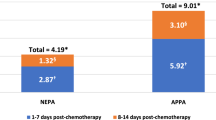Abstract
Ondansetron has had a major impact on the prevention of emesis in patients receiving chemotherapy. However, the high cost and potential for inappropriate prescribing of this agent warranted a closer examination of its utilization. Hospital guidelines regarding the use of ondansetron were prepared by the Pharmacy and Therapeutics Committee and approved by the Medical Advisory Committee. The guidelines were then distributed to all physicians. Physicians were randomized into an intervention or non-intervention group. A prospective drug use evaluation was then conducted for a 10-week period where pharmacists monitored ondansetron prescribing and compared each order against hospital guidelines. For orders deemed inappropriate, only the intervetion-group physicians were contacted for therapy modification. The control of nausea and vomiting was then assessed for all patients 24 h and 72 h after chemotherapy via a simple patient questionnaire. There were no significant differences with respect to the control of nausea and vomiting between patients who received ondansetron according to guidelines and those who did not. A total of 76% (48/63) of the prescriptions met hospital guidelines in the intervention group compared to 51.6% (33/64) in the control (P=0.007). During the study period, physicians in the intervention group prescribed $Can 757 worth of ondansetron inappropriately compared to $1814 in the control. Drug use evaluation with pharmacist intervention was an effective method of controlling unnecessary hospital costs and contributed towards the appropriate use of on-dansetron without compromising patient care.
Similar content being viewed by others
References
Bakowski MT (1984) Advances in anti-emetic therapy. Cancer Treat Rev 11:237–256
Bamberger DM, Dahl SL (1992) Impact of voluntary vs enforced compliance of third-generation cephalosporin use in a teaching hospital. Arch Intern Med 152:554–557
Blackburn JL (1993) Impact of drug usage review on drug utilization. Pharmacoeconomics 3:14–21
Cupissol DR, Serrou B, Caubel M (1990) The efficacy of granisetron as a prophylactic antiemetic and intervention agent in high-dose cisplatin-induced emesis. Eur J Cancer 26 [Suppl 1]:S23-S27
Einarson TR, Segal HJ, Mann JL (1989) Drug utilization in Canada. J Soc Admin Pharm 6:69–82
Ezzy JA, Chetcuti NL, Peacocke GH, et al (1993) Drug utilization review of ondansetron in four Sydney Metropolitan Hospitals. Aust J Hosp Pharm 23:312–317
Goad JD, Ezell JR (1990) Drug-use evaluation programs for psychotropic medications. Am J Hosp Pharm 47:132–136
Harris JR, Marrow M, Bonadonna G (1993) Cancer of the breast. In: Devita VT, Hellman S, Rosenberg SA (eds) Cancer principles and practice of oncology, 4th edn. Lippincott, Philadelphia, pp 1264–1315
Hesketh PJ, Gandata DR (1991) Serotonin antagonists: a new class of antiemetic agents. J Natl Cancer Inst 83:613–620
Hoffman RP (1984) A strategy to reduce drug expenditures with a drug utilization review program. Hosp Pharm 19:7–12
Kirking DM, Svinte MK, Berardi RB, et al (1991) Evaluation of direct pharmacist intervention on conversion from parenteral to oral H2-receptor antagonist therapy. Ann Pharmacother 25:80–84
Lazor-Bacjar LM, Fowler R (1988) The development and implementation of a drug utilization review program. Can J Hosp Pharm 41:11–16
Lindley CM, Hirsch JD, O'Neill CV (1992) Quality of life consequences of chemotherapy-induced emesis. Quality Life Res 1:331–340
Marty M (1989) Ondansetron in the prophylaxis of acute cisplatin-induced nausea and vomiting. Eur J Cancer Clin Oncol 25 [Suppl 1]:S41-S45
Marty M, Pouillart P, Scholl S, et al (1990) Comparison of the 5-hydroxytryptamine3 (serotonin) antagonist-ondansetron (GR38032F) with high dose metoclopramide in the control of cisplantin-induced emesis. N Engl J Med 322:816–821
Pastel DA, Chang S, Nessim S, (1992) Department of pharmacy-initiated program for streamlining empirical antibiotic therapy. Hosp Pharm 27:596–603
Peters MD, Long KS, Patel HS (1993) Multicenter evaluation of ondansetron use in hospitalized oncology patients. Am J Hosp Pharm 50:1164–1170
Rusthoven J, O'Brien BJ, Rocchi A, et al (1992) Ondansetron versus metoclopramide in the prevention of chemotherapy-induced nausea and vomiting: a meta-analysis. Int J Oncol 1:443–450
Sanchez L (1994) Practical applications in pharmacoeconomics. Pharmacoresources 1:13–14
Soumerai SB (1988) Improving the quality and economy of in-hospital prescribing: getting more for less. Med J Aust 149:574–576
Tonato M, Roila F, Del Favero A (1991) Methodology of antiemetic trials: a review. Ann Oncol 2:107–114
Author information
Authors and Affiliations
Rights and permissions
About this article
Cite this article
Dranitsaris, G., Warr, D. & Puodziunas, A. A randomized trial of the effects of pharmacist intervention on the cost of antiemetic therapy with ondansetron. Support Care Cancer 3, 183–189 (1995). https://doi.org/10.1007/BF00368888
Issue Date:
DOI: https://doi.org/10.1007/BF00368888




